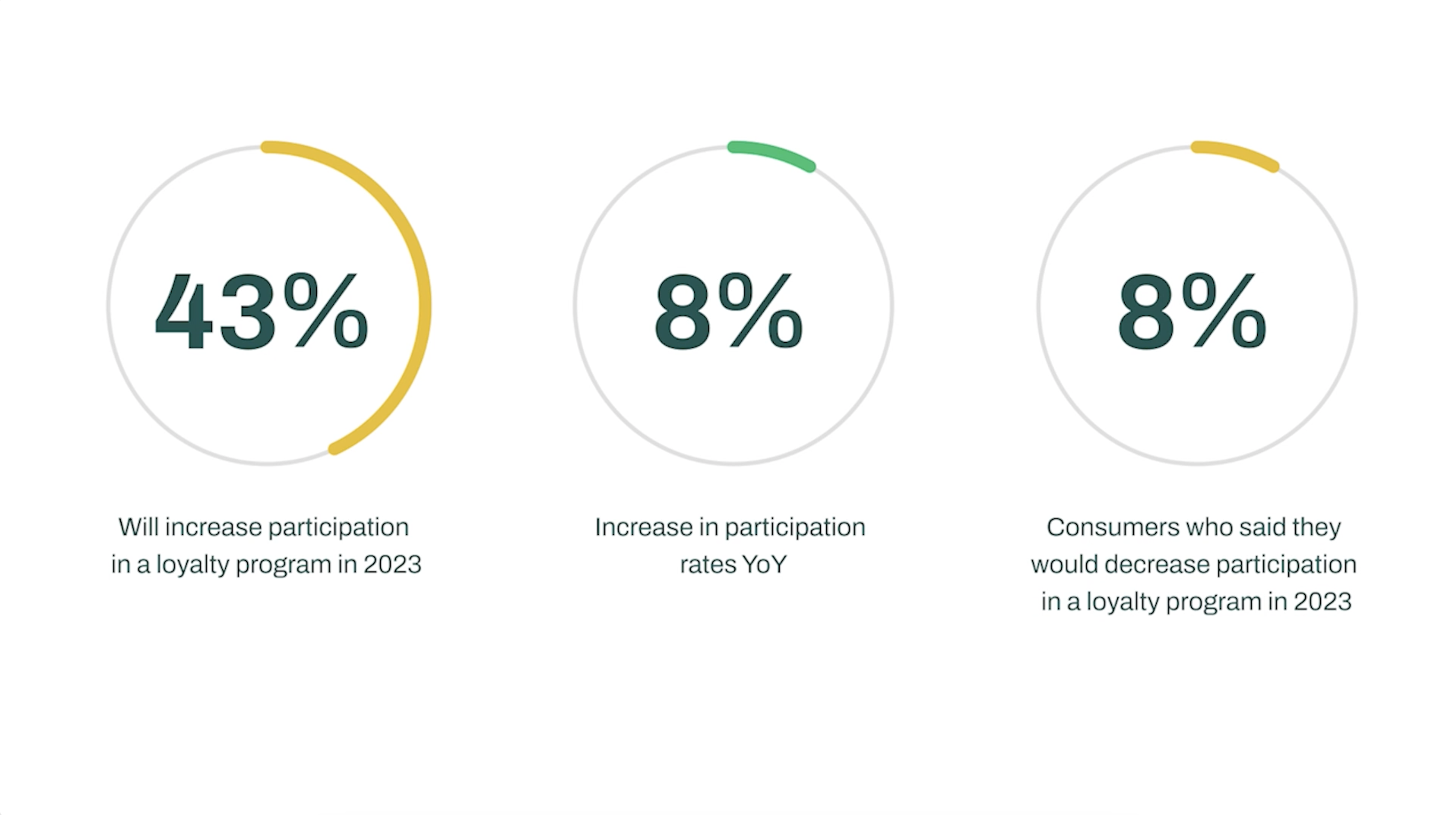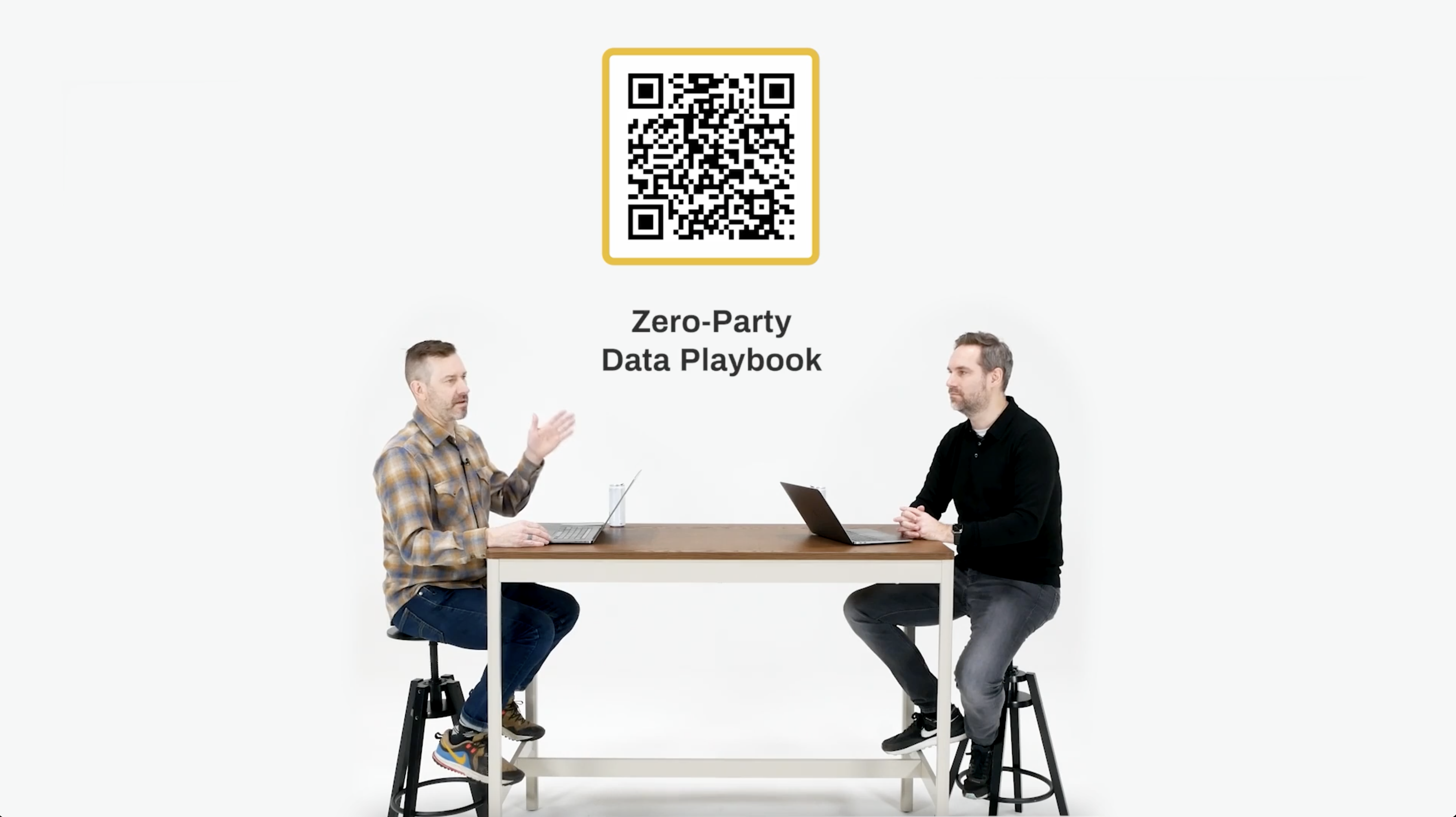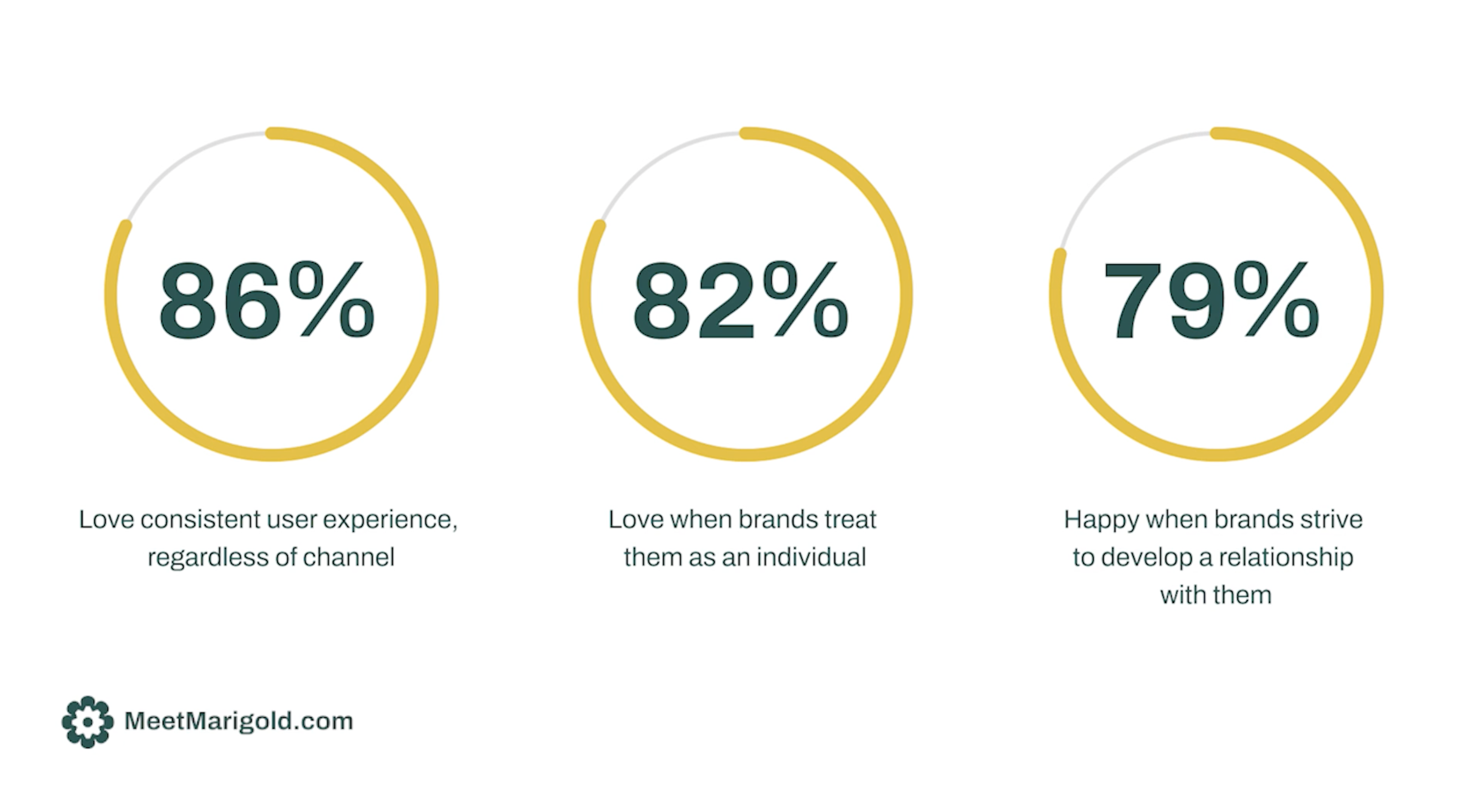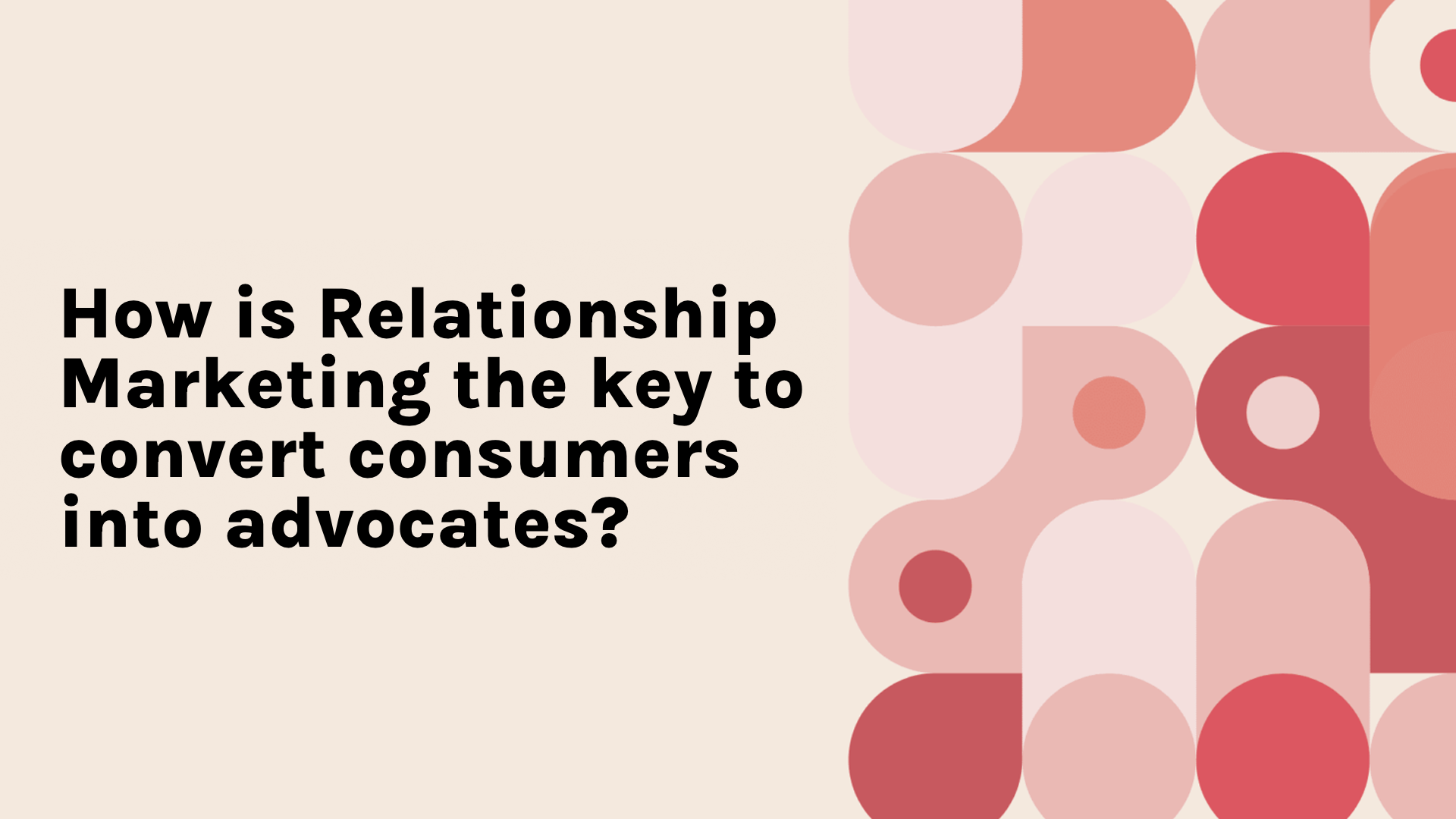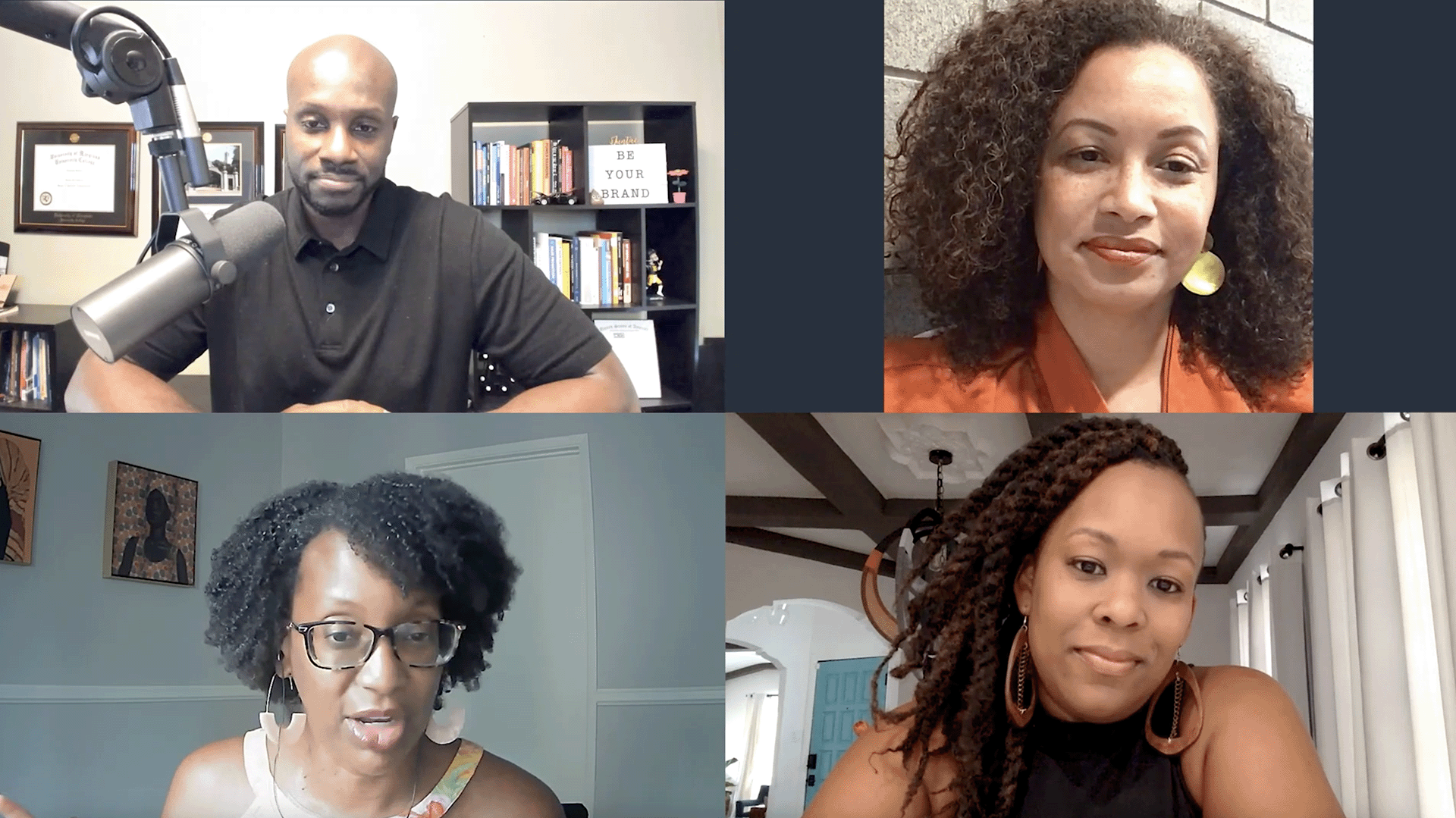Building a Business with Email: How The Gist Scales with Campaign Monitor
- 0.5
- 1
- 1.25
- 1.5
- 1.75
- 2
Tim: Welcome, I'm Tim Glomb, VP of content here at the CM Group, and I am pleased to be in Toronto with, collectively, The Gist. Thanks for having me here in Toronto, I appreciate your time.
Ellen : Oh my gosh, thanks for being here.
Tim: I am here with Ellen, Roslyn, and Jacie, and you are collectively The Gist. Ellen, what do you do at The Gist?
Ellen : Yes, so I'm one of the co- founders, alongside Roslyn and Jacie, and I am our head of content. Really in charge of things like our strategy on the newsletter, podcast, social media side of things, where we're going next on the organic side, but also on the branded content side of things. I'm working with an amazing team of women to put out all the content that our audience sees.
Tim: I can't wait to dig into that a little deeper and really understand what The Gist is about, but Roslyn, what do you do at The Gist?
Roslyn : I'm our Head of Operations and Growth. I was a CPA in another life, so I oversee all things, day- to- day operations, technology, finance, audience growth, really just making sure everything is working efficiently and that we're making data driven decisions and that there's cash in the bank ultimately to fund all of our future growth and strategy.
Tim: Super important, we're going to talk about that too because there's always got to be cash in the bank.
Roslyn : There it is.
Tim: And Jacie, what's your role at The Gist?
Jacie : I lead our revenue and partnerships. All of our content is free, so we work with certain brand partners that are a really good fit with our audience and our value. Speaking of cash, we're all about the top line, all about bringing in the money.
Tim: Sure.
Roslyn : Also, very instrumental to making sure there's cash in the bank.
Jacie : Yes.
Tim: Good.
Jacie : So that we can spend it.
Tim: Well look, we're going to dig into that. But first for everybody who's watching who's not familiar, I am, I signed up for the newsletter, I get my great Denver feed because that's where I'm from. Tell me what is The Gist? How do you explain what The Gist is?
Jacie : We are really a female founded sports media startup and we're all about making sports more accessible, more inclusive and just more fun too. That kind of underserved sports fan, which really we all identify as and so many of our Gisters identify as. We do that primarily through digital content as well as experiences and community. Our main channels that Ellen really oversees are our newsletter, our social channels and our podcasts. But really through all of those channels, we are all about empowering more underserved sports fans and again, really making sports that much more accessible and inclusive because it just hasn't always been that way.
Tim: Got it. But it's, tell me about the female aspect of that because obviously you're three strong females and sports fans and athletes yourselves. What's the value of the female perspective to The Gist?
Ellen : Yeah, so one thing that we noticed in the sports industry is that 14% of sports journalists are women. Less than 4% of coverage is on female athletes and women's sports in general. And as a result it's no wonder why so many women as well as other underserved sports fans feel this sense of disenfranchised- ness, I guess, from sports and the sports community. And so when you look at that, we think that really sports are for everyone. They're the social currency in our society. They have this really unique power to unite people regardless of age, race, gender, religion, what have you but still women were left out of the community. And really our mission with The Gist and leveling the playing field is providing equal coverage on men's and women's sports. You can come to The Gist to get The Gist of what's happening in the NBA at the exact same time, you're going to get The Gist of what's happening in the WNBA, all of our team, our women, we have 100% female journalists, 100% sales team, operations, growth, what have you. That is very opposite to what you see generally in the sports' industry. And as a result, our content is different and the audience that we're speaking to is different. And really the goal is to make it so that sports are for everyone as opposed to sports really being for the avid male sports fan.
Tim: I love it. We're going to dig into that a little later. I really want to get into what's happening in the women's movement right now at this time, at the day and age in sports. But I have to ask you, why start with email newsletter, right? That's where you started with this, correct? Why was that the easiest on ramp to this idea that you collectively had?
Ellen : Yes. When we first came up with the idea for The Gist, all three of us had been subscribed to The Skim. We had been subscribed to Morning Brew and as young on- the- go professional women, it really was a great source for us to learn about what was going on in the business world, to learn about what was going on in news in general. And we really felt like we needed a place for that for sports because the websites that you see was sports, whether it be TSN or ESPN or SportsNet or Fox News, very male dominated pages. You really had to know all of the jargon and the acronyms and all of that sort of stuff. And there wasn't really a go- to centralized place where you can find out about sports in the same way that there's go- to centralized place with business news or general news that we found with the Skim in Morning Brew. And as consumers ourselves and as sports fans ourselves, we thought this would be a really great way for us to start creating content, building a community, and trying things out with our newsletter to prove that this is a great idea. And once we prove that with the newsletter, that's where we started to expand into other channels as well.
Tim: Got it. You talked about the idea, you talked about being sports fans. Let's go back a second. How did the three of you get together and bring this idea to life to even create The Gist?
Jacie : We all met at Queens University, we all went to college together. We've been friends for a while and after university we were all working in different areas of financial services, right here in downtown Toronto. And we were just really catching up on a random Tuesday night and we're each talking about our careers and what the latest was going on. And Ellen of the three of us has always been just that insanely avid sports fan and not just amongst the three of us but just in general. And she was telling us about the Leafs game the night before and it was really engaging and really fun. Ros and I grew up playing so many sports, but it didn't really translate to being a really avid sports fan in the same way that it did for El. And there was just something really captivating about the way that she was talking about sports and her fandom was so infectious. And again, just with us all being at that stage in our careers and in those very corporate male dominated kind of spaces within finance too, we also very quickly saw how sports really are that social currency and knowing what is happening in sports can really be leveraged and sports are really a microcosm for our society as well. And so there were a few different things that were swirling in our heads that night as we also had a few glasses of wine. And it was really that night though and very organically where we were like there's something missing in this space that would deliver sports content in a way that's fresh from that female perspective that's actually exciting and engaging. The way that EL was speaking to the game the night before provided just that additional context that we didn't have, had that more progressive view on what's happening in sports that we didn't have, that somebody like Roslyn and I and so many other women or Gisters out there would really benefit from, whether that's in their professional lives and their personal lives that want to be part of the sports community but don't necessarily feel like they can be or that it's for them. And we really went straight to newsletter it that very night and thought of the newsletter as a really interesting way to have to really to build a community and to have that really purposeful read that we spoke about earlier too.
Tim: Great. It sounds like an awesome night. Wish I was a fly on the wall on that one. You came up with a great idea, you found a problem and you're trying to solve it. You created a newsletter and it's evolved from there, right? Because it's not just a newsletter now. What else is The Gist? You've got podcast, tell me what all the products and services are for the Gisters.
Ellen : Yes, we've got it all. I do want to start with the newsletter though. Our newsletter evolved from one time a week to now, it's a four times weekly newsletter that gives you The Gist of what's up in the sports world, both on the men's side as well as the women's side. And as you mentioned, it is regionalized as well. We have regionalized our content for Canada as well as the US. If you live in Canada, you're getting different content than if you're in the US. And then we've also regionalized our content based off of 10 different major cities across North America as well. You right now would be hearing all about the Colorado Avalanche inaudible.
Tim: Everybody should be hearing about the Colorado Avalanche.
Ellen : Exactly. Everyone's hearing about that. Everyone's hearing about how they're denting the inaudible the times.
Tim: We're just... Yeah.
Ellen : Exactly. Whereas folks in New York might be hearing about Sabrina Ionescu winning player of the month for the New York Liberty. So we're really thinking about how we can engage our readers and our audience in a specific way of what matters most to them because we know that sports are also a really unique local experience as well. So that's our main newsletter, that's our sports newsletter. And then we've also recently launched our women's sports business newsletter. And what we really found is that there's this white space in terms of reporting of what's happening on the business side of women's sports. So how are partners working with different leagues and teams and athletes, What's happening in the M&A space where our people and folks expanding into in that side of things. So that was recently launched at the end of February and that's a three times weekly newsletter that is really across the globe. We're talking about what's happening in Europe, we're talking about what's happening in North America. So those are two newsletter products right now. And then from there, we also have Canadian and US specific content on Instagram as well as our socials. Oh sorry, on Instagram as well as our Twitter. So @ thegistusa as well as @ thegistca on both our Instagram and Twitter. And on TikTok we are @thegistsports. So we're everywhere on socials. And then finally we have a twice weekly podcast called The Gist of It that gives us the opportunity to dive into conversations that are a little bit more intersectional in nature that our audience really enjoys that has that sports side, but also what's happening in culture more broadly.
Tim: Wow. You have so many products, you've got such a vision and great connection. But I want to hit on something that you talked about there. When the regionalization, we believe here at the CM Group that relationship marketing is really the business we're all in. I don't care if you're Tony or Sue's Pizza place with one location, your first business, or you're as large as a Starbucks or a global enterprise brand, you need to build relationships. And part of building relationships means understanding each other. It's not a one way bullhorn that you're just pumping out there. So I live in Denver, as I mentioned, I get the Denver feed. But stage one in relationship marketing is really acquisition. You have to turn somebody from an unknown contact, you don't know their name, you don't know anything about them, you engage them and you now get them into your fault. For you, probably get them onto the newsletter. How do you look at acquisition and what are some of the ways that you're acquiring new contacts, new people, new leads into The Gist program?
Roslyn : Yeah, there's a whole bunch of different ways that we approach growth from. We have a bunch of different growth channels. I think at that really early stage where somebody isn't aware of The Gist and in order to get on their radar, we really focus on the problem that we're looking out to solve. So through any of our paid advertising across socials, which is one of the place places where a lot of our audience is already hanging out, Instagram, TikTok, we really try and hook them in with the problem in one line. So you want to keep up with sports but you don't know where to start or you're tired of male dominated sports. Well let me tell you more, that kind of thing or from a PR perspective, really just focus on the mission. And that really tends to resonate with, people tend to want to learn more about a company that is trying to make a change in the space, especially with younger generations that really want to align their own personal values to the companies and media that they interact with. Another way that we look at is cross promoting with other brands that have similar audiences to us. Whether that's like a Girlboss or a Morning Brew, other newsletters obviously tends to be a really amazing way for us to get in front of the exact audience that we want to bring onto our list referral program, word of mouth has been really effective for us and leveraging our own audience to tell people in their lives that would definitely benefit from The Gist and face the same problems that they're experiencing.
Tim: So as far as growth, though you have exploded, are you willing to share what your explosion and growth look like?
Roslyn : Yeah, yeah, definitely. We've been so happy and proud to see it over the last year and a half. We've gone from a hundred thousand to half a million on our newsletter and over 750,000 across all of our channels, which feels so amazing I think because it just shows that we've hit on a problem that is really widespread and we've done it in a compelling way that resonates with a lot of people and it's just been so exciting and rewarding to see for us and our whole team.
Tim: Yeah. That's great. And obviously something's resonating, but let's talk about engagement because that's like stage two in relationship marketing. Once you acquire them and start to understand them, you have to engage them. What are the things that are working for you in an engagement and how do you measure engagement? Is it open rate? Is it click rate? Is it something different? What does engagement look like at The Gist?
Ellen : Yes. So as far as creating content, really for us, it's about making sure that it's the highest of quality content that our Gisters are going to want to read and love consistently. So we are looking at things in terms of our KPIs, definitely at our open rates, we're looking at our open rates in Canada versus the US versus different regions. We're looking at our click through rates, we're looking at our branded click through rates, we're looking at feedback from our audience. We get a lot of emails every single day, every single time we send out an email of people saying, " Hey, you missed this," or" Hey, we loved this. We'd love to hear more about X, Y, and Z." So there's a lot of quantitative as well as qualitative work that goes into it. I think a lot of it is the consistency and we really want to be landing in people's inbox as that one- to- one relationship, as Jacie mentioned, that really, really purposeful read and we want to be also surprising and delighting our audience and being that ray of sunshine, I guess you could say in an email, we know that a lot of the times you get inundated with spam emails or too many emails from your manager or your boss, we want to be that email that you actually want to open. And so those consistent open rates as well as click through rates are definitely something that we are looking at and seeing how our content is resonating that way too.
Tim: Yeah, well you're right. I have 600, 000 unopened emails on my home screen. Makes me a little nervous sometimes, but you're right, it's about building that relationship and having people recurringly open the things that they care about and retention, right? So you've acquired, you have a great growth trajectory, you have great engagement, people are obviously enjoying the product. What does retention look like? What do you look at as retention or really even loyalty to The Gist? How do you measure that and how do you foster that?
Ellen : Yes, I think that there's probably a couple of ways to think about retention. So I can speak about it to the content side of things that maybe we can think about the growth mix side of things too, because it does depend on who that audience member is, what growth channel they're coming from and why they're landing on The Gist. And I think a lot of the information that we're gathering quantitatively as well as qualitatively all lead to, okay, how are we going to retain this audience member? And a big piece for us is making sure that they're in it for the long haul and that their lifetime value really works out for years and years on end. So it's a lot more than just, okay, can we retain them for a quarter? Can we retain them for the Olympics? We know that, that's going to be something that our audience cares so much about with those pop of events like the Super Bowl, the Olympics, the World Cup. It's about how can we keep them engaged year, over year, over year. And a lot of that does come back to the content and is it high quality? Is it what they are looking for? Is it what we marketed to them? And it's about consistently iterating and changing things based on our audience's feedback to ensure that we are able to retain that audience member, especially after we've paid to try to bring them onto the platform. So lots of things obviously go into that on the content side of things, but also the design of the email as well. And then Ros, if you want to talk about the growth side of retention too.
Roslyn : Yeah, for sure. We definitely try to leverage data analytics to understand our attention, who we're retaining, where they came from, and then make adjustments based on that information to make sure that we're providing a really personalized life cycle experience to people based on what we know about them and where they came from and what lists they're signed up to. And also just to reinvest into the growth channels that we know are really high quality for us so that we go to the places where we know we're going to get people that are a really good fit for our content and we'll stick around in the long term.
Tim: Yeah.
Jacie : One more aspect on the retention side too is that we're in such a unique position to really grow someone's fandom. We do have so many people that sign up for The Gist who, again, just haven't really felt like sports is for them and maybe on the more casual fan side. So there is something about that just fan journey as well and that depth and breadth in their sports knowledge and just their love of sports and different sports and women's sports that we are in a really amazing position to really grow too. So that really helps with engagement and retention as well. And that also factors into a lot of our partnerships. So many different brands, leagues teams want to work with anyone that's growing the entire pie for the sports industries.
Tim: I want to learn about those partnerships and because again, we talked cash in the bank, you got to have some partnerships, but I don't want to lose a thought that Roslyn mentioned here. You talked about data analytics. What is resonating, what are people looking at? And personalization? Personalization. 74% of global respondents last year in our consumers trends index that we do every year, 74% said they get irrelevant content and offers from the brands where they're signed up on an email newsletter in particular, incredibly frustrating. What does the future of personalization look like at The Gist? Will you get to that individualized machine learning, AI state or tell me what does personalization look like in the future for The Gist?
Ellen : It's a great question. We're definitely keeping our finger on the pulse. I think that it is a little bit difficult being in the content space, but also being in the sports space where it's changing literally minute to minute, hour to hour, what we're actually going to be talking about newsletter- to- newsletter as well. And so there's always going to be a certain aspect where our audience is signing up for The Gist because we're curating what they need to know. We're providing context on what we feel like they need to know and we're leaving out the things that we feel like they don't need to know or that aren't important. And so for us right now that personalization is already the content that we are providing them because we're thinking about The Gister at the end of that journey as well as all of the different regions that we're having, the different newsletters that they're able to sign up for as well, they're choosing The Gist themselves. So it's already a little bit personalized that way. I think another piece of it too, when you're not able to necessarily have a one- to- one email every single time is that we're really purposeful in the way that we write our content. So jokes are always very one- to- one. So it's never popcorn anyone? Because that seems like very, very broad. We're talking to all of these people, we want the jokes to feel like, Hey, what did you think of this? Or hey, play this song. We want it to feel like we, The Gist, are talking to you specifically. So that as much as it is a newsletter that's going out to 500, 000 people, when it's landing in your inbox, you just feel like we're having a conversation. So that's where we're at right now, but we're definitely keeping our finger on the pulse and seeing what the opportunity is in the future to potentially make it more personalized.
Tim: Well, you're at a great home here at the CM Group. We have amazing personalization capabilities at scale, but that's great. You are curators, you're passionate, you know what to pull and what to put it in that feed. So, that's great context. Let's talk about though the revenue and the partnerships because you have some amazing partnerships with some giant brands in the sports space. Can you explain a little bit about what partnerships and revenue look like for The Gist?
Jacie : Yeah, sure. We started really focusing on bringing on the right brand partners once our audience really met a meaningful size too. We do primarily monetize through those brand partners as well. So we've tried to be really intentional and thoughtful about which partners we are really putting in front of our audience and really recommending to our audience as well. We've also worked really hard over the last few years to really develop our offering and really iterate on our offering to our brand partners to ensure that we're really driving the impact that they're looking for. I think that fan journey that we spoke about is a huge part of that and really why so many brands want to work with us is because we really specialize in changing perceptions. And whether it's in the sports betting space, whether that's a beer company, a car company, what have you, there are a lot of different brands and products and services that we'll do a traditional sports media buy that A, our Gisters just aren't seeing and B, if they are seeing it, it's really not resonating. So we really take that step back, think about our Gisters, what's really going to authentically engage them and then work with our partners accordingly. So we have had really amazing partnerships with Under Armour, Nike, Adidas, from a sports league side, the NBA, the WNBA and a few different teams as well, FanDuel. And there's a few other sports books that are some of our largest partnerships today. But we've been really proud of how we've been able to monetize and how we've been able to really learn from our partners as well over the last few years.
Tim: That's great context. I'm sure there are people watching right now going, " Hey, I want this trajectory, I want that growth, I want those partners, I want that revenue." So knowing what your audience wants and balancing that with what your partners need is incredibly important. Speaking of partners, we here at the CM Group and you're using the Campaign Monitor platform, how are we as partners from a service perspective? Obviously Ellen and I are going to dig in to another session where we talk about the platform tips, tricks, practitioner level things, but in general, how is it working with the CM Group?
Ellen : It's been great. When-
Tim: Well, that's good.
Ellen : It's been great. When we were first introduced to Campaign Monitor, Roslyn and I were on a call with one of your sales folks and we were learning about all of the customization that you can do in the back end in terms of just coding for different cities and all of these different regions that we wanted and all of the lifecycle emails that we're able to do on Campaign Monitor that we weren't able to do with our original email software. And it was such a pain point for us that when we were on the call with Campaign Monitor and we found out that we could be sending in one click to all of our audience across all of the 10 different locations and all of the different content that we have, I literally almost started crying because it was-
Roslyn : She did start crying.
Ellen : I literally did start crying because with the prior email software system, it would take just to do operations on an email, three hours because we had so many different types of content for different people in different locations versus now we're able to pretty seamlessly transfer the content that we're creating in Google Docs into Campaign Monitor for every single location. So it's this huge document and send it out at the same time and it's just saved us so much time. So that's been amazing. And then Roslyn works with the team, I feel like a lot on if we do have any issues, stuff on the growth side, data analytics side too.
Roslyn : Yeah, the team has been awesome and very supportive for all the issues that always end up coming up for any email company. Yeah, super responsive, super helpful and understanding of all of our issues. And also I think understanding of and wanting to be on top of where we're going next with the company and how CM Group can continue to support us in all the future opportunities that we see for The Gist too and making us aware of how CM Group is evolving too and the new features and functionality that you have and where there could be a fit for all that as well.
Tim: Well, we love to say we're a home for every marketer. Whether again, you're Tony or Sue's Pete's place or you're a giant enterprise brand, we've got a product for you. So, that's great to hear. But speaking of that, let's end the business side of this because I do want to talk about sports. Where we are today with females place in sports and society. But last question, what's the growth look like for Gist? What's next for The Gist? What are The Gisters going to expect for you over the next year or so?
Ellen : So as far as content goes, we had mentioned that we have our sports newsletter, we have our sports business newsletter, but very excited to share that we are going to be launching a college sports newsletter specifically at the end of August. That is definitely one thing that our Gisters have been asking for such a long time. They've been going bananas over our college content over the last couple of years. And so we thought that it really is time to be creating content specifically for the NCAA. That is going to be a regionalized newsletter as well. So yes, there's going to be national stories that will be going out across the US but we're also going to regionalize it based off of the Power Five conferences. And those conferences are shifting a lot right now, which is very interesting. But that will be regionalized and so we're going to launch with Week Zero in the football season and are really looking forward to some really great coverage throughout March Madness as well.
Tim: Wow, I love it. And I'm sure more partners, more opportunities. Hopefully for you, more cash in the bank.
Ellen : Yeah, exactly.
Tim: All right, well look, let's shift our focus for a second because I'm sure you guys have a great perspective on this and I'm a middle- aged white guy from the middle of America. I'm not a huge sports fan to be honest with you. Not organized sports, at least. Skateboarding, snowboarding, things like that. But tell me your opinion on this and where we stand today. 50 years ago, in June of 1972, US President Richard Nixon signed into law Title Nine, which basically brought equality. It was meant to be a framework to bring equality between genders in sports. Where are we today in 2022? Are we where we need to be or are we at least on the right path?
Ellen : We're not where we need to be, for sure. I think that we can all agree on that and that's part of the reason why The Gist exists period. We wouldn't have to exist if the sports industry was where it needed to be, quite simply. And so we're not where we need to be, but we are in the right direction. Because of Title Nine, the amount of athletes that are participating in college sports have increased. The amount of athletes that are participating in high school has increased. The pro leagues have actually happened. You know what I mean? They actually started on the women's sports side of things, which is amazing. But I think when you're also looking at how sports have evolved, a lot of full ride scholarships are going to white women as opposed to bi- poc women. There's a lot more focus on a lot of white women on the professional side of things. When you're looking at WNBA marketing or US women's national team, there is still a lot more funding and resources that are going into men's sports in the college space, men's sports in the professional space, of course as well, that women do need to have access to that we're just simply not having access to right now. But it is still growing and it is still going in the right direction. So the amount of athletes that you were seeing in the seventies has almost 500x- ed to today, which is amazing and it makes me, and I think all of us really excited for what could happen in the next 50 years.
Tim: Well, I agree. This has been great. You've taught me a lot today. We've opened a great discussion. I hope we've inspired you, the viewer, to think differently. Check out The Gist. They're doing some great things. Go sign up right now, follow their story. We'll definitely have you back. I appreciate you having me in Toronto. We'll see you on the next event.
Ellen : Thanks so much.
Roslyn : Thank you.
Jacie : Thanks so much for having us.
DESCRIPTION
Content businesses have thrived using the email channel for monetization, but how do you start and drive growth? What are the hurdles to get off the ground? How do you leverage strategic partnerships to further build your audience and build revenue?
Launched in 2018 by three college friends — Jacie deHoop, Ellen Hyslop and Roslyn McLarty — The GIST is all about changing the game in the male-dominated sports industry where less than 14% of journalists are women and less than 4% of coverage is on female athletes. Three years later, their all-female, 20-person team works day in and day out to change those stats, providing equal coverage on men’s and women’s sports to empower underserved sports fans.
Join us for a conversation about how in 3 years, The GIST has grown their subscriber list 4x (from 100k to 500k+ in the last year), added a popular podcast, The GIST of It, to their 4x/week newsletter, regionalized their content for 10 major cities across North America, and continue to engage audiences with exciting partnerships and new content offerings like their women’s sports business newsletter and new college sports newsletter.
Takeaways:
- Finding the balance between quality and growth can be hard. Newsletters grow faster when you understand the data analytics of where your audience is coming from and which channels are allowing higher quality growth so you can properly segment.
- Providing a value exchange through referral programs strengthens acquisitions, as does using automation tools to hone in on a user’s specific city and initially beta testing the length, the design, and the tone of voice to develop more long-term loyal subscribers.
- Thoughtful, strategic brand partnerships can drive revenue and growth, while also strengthening relationships with their audience. The GIST built partnerships with Under Armour, Nike, Adidas; from a sports league side, the NBA, the WNBA, and a few different teams as well, Fanduel.
Today's Guests

Ellen Hyslop

Tim Glomb

Jacie DeHoop



